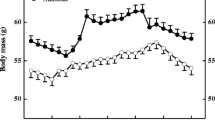Abstract
Standard metabolic rate of birds has been measured by flow-through respirometry based on their standard O2 consumption and CO2 release during the day- and nighttimes in a darkened chamber at a constant temperature of 25°C. The research was carried out in October–March 2009–2013, in the western part of Moscow region. The standard metabolic rate and respiratory quotient of coal tits have well-pronounced diurnal rhythms reaching their minimum in the nighttime (from 2:00 a.m. to 5:00 a.m.) and maximum in the daytime (from 11:00 a.m. to 2:00 p.m.). A significant linear dependence has been found between an increase in the standard metabolic rate and that in the respiratory quotient. The maximum difference between values of the standard metabolic rate during the day- and nighttimes is 55%. It may be concluded that the main elements oxidized at night are fat reserves, whereas proteins, as well as a mixture of proteins, fats, and carbohydrates, are oxidized during the daytime.
Similar content being viewed by others
References
McKechnie, A.E. and Wolf, B.O., The allometry of avian basal metabolic rate: good predictions need good data, Physiol. Biochem. Zool., 2004, vol. 77, no. 3, pp. 502–521.
Konarzewski, M. and Ksiazek, A., Determinants of intra-specific variation in basal metabolic rate, J. Comp. Physiol., B, 2012, vol. 183, pp. 27–41.
McKechnie, A.E., Phenotypic flexibility in basal metabolic rate and the changing view of avian physiological diversity: a review, J. Comp. Physiol., B, 2008, vol. 178, no. 3, pp. 235–247.
Aschoff, J. and Pohl, H., Rhythmic variation in energy metabolism, Fed. Proc., 1970, vol. 29, no. 4, pp. 1541–1552.
Kendeigh, S.C., Dolnik, V.R., and Gavrilov, V.M., Avian energetic, in Granivorous Birds in Ecosystem, Pinowski, J., and Kendeigh, S.C., Eds., Cambridge: Cambridge Univ. Press, 1977, pp. 78–107.
Gavrilov, V.M., Daily measurements of resting metabolism in birds, Ornitologiya, 1981, vol. 16, no. 15, pp. 42–50.
Pohl, H., Circadian rhythms of metabolism in cardueline finches as function of light intensity and season, Comp. Biochem. Physiol., Part A: Mol. Integr. Physiol., 1977, vol. 56, no. 2, pp. 145–153.
Gavrilov, V.M., Seasonal and circadian changes of thermoregulation in passerine and nonpasserine birds: which is more important?, in Acta XVIII Congressus Internationalis Ornithologici, Ilyichov, V.D. and Gavilov, V.M., Eds., Moscow: Nauka, 1985, pp. 1254–1277.
Saarela, S., Klapper, B., and Heldmaier, G., Daily rhythm of oxygen consumption and thermoregulatory responses in some European winter- or summer-acclimatized finches at different ambient temperatures, J. Comp. Physiol., B, 1995, vol. 165, no. 5, pp. 366–376.
Gavrilov, V.M., Kerimov, A.B., Golubeva, T.B., Ivankina, E.V., Il’ina, T.A., Karelin, D.V., and Kolyaskin, V.V., Energetics, morphophysiological heterogeneity of individuals, and population structure in birds. I. Energy, morphophysiological heterogeneity, and population structure of the great tits of Moscow, Ornitologiya, 1996, vol. 27, pp. 34–73.
Woodin, M. and Stephenson, R., Circadian rhythms in diving behavior and ventilatory response to asphyxia in canvasback ducks, Am. J. Physiol. Regul. Integr. Comp. Physiol., 1998, vol. 274, pp. R686–R693.
Arens, J.R. and Cooper, S.J., Seasonal and diurnal variation in metabolism and ventilation in house sparrows, Condor, 2005, vol. 107, no. 2, pp. 433–444.
Swanson, D.L. and Liknes, E.T., A comparative analysis of thermogenic capacity and cold tolerance in small birds, J. Exp. Biol., 2006, vol. 209, pp. 466–474.
White, C.R., Blackburn, T.M., Martin, G.R., and Butler, P.J., Basal metabolic rate of birds is associated with habitat temperature and precipitation, not primary productivity, Proc. R. Soc. B, 2007, vol. 274, no. 1607, pp. 287–293.
McNab, B.K., Ecological factors affect the level and scaling of avian BMR, Comp. Biochem. Physiol., Part A: Mol. Integr. Physiol., 2009, vol. 152, no. 1, pp. 22–45.
Swanson, D.L., Seasonal metabolic variation in birds: functional and mechanistic correlates, Curr. Ornithol., 2010, vol. 17, pp. 75–129.
Schmidt-Nielsen, K., Animal Physiology: Adaptation and Environment, Cambridge University Press, Cambridge, 1980.
Walsberg, G.E. and Wolf, B.O., Variation in the respiratory quotient of birds and implications for indirect calorimetry using measurements of carbon dioxide production, J. Exp. Biol., 1995, vol. 198, pp. 213–219.
Lighton, J.R.B., Measuring Metabolic Rates. A Manual for Scientists, Oxford: Oxford Univ. Press, 2008.
Powers, D.R., Diurnal variation in mass, metabolic rate, and respiratory quotient in Anna’s and Costa’s hummingbirds, Physiol. Zool., 1991, vol. 64, no. 3, pp. 850–870.
Prinzinger, R., Schafer, T., and Schuchmann, K.-L., Energy metabolism, respiratory quotient and breathing parameters in two convergent small bird species: the fork-tailed sunbird Aethopyga christinae (Nectariniidae) and the Chilean hummingbird Sephanoides sephanoides (Trohilidae), J. Therm. Biol., 1992, vol. 17, no. 2, pp. 71–79.
Suarez, R.K., B. Lington, J.R., Moyes, C.D., Brown, G.S., Gass, C.L., and Hochachka, P.W., Fuel selection in rufous hummingbirds: ecological implications of metabolic biochemistry, Proc. Natl. Acad. Sci. U.S.A., 1990, vol. 87, no. 23, pp. 9207–9210.
Ptushenko, E.S. and Inozemtsev, A.A., Biologiya i khozyaistvennoe znachenie ptits Moskovskoi oblasti i sopredel’nykh territorii (Biology and Economic Value of Birds of Moscow and Adjacent Areas), Moscow: Mosk. Gos. Univ., 1968.
Author information
Authors and Affiliations
Corresponding author
Additional information
Original Russian Text © V.V. Gavrilov, G.V. Morgunova, 2014, published in Vestnik Moskovskogo Universiteta. Biologiya, 2014, No. 4, pp. 46–50.
About this article
Cite this article
Gavrilov, V.V., Morgunova, G.V. Diurnal rhythms of standard metabolic rate and respiratory quotient in the coal tit (Periparus Ater, Aves) during the autumn-winter period. Moscow Univ. Biol.Sci. Bull. 69, 184–188 (2014). https://doi.org/10.3103/S009639251404004X
Received:
Published:
Issue Date:
DOI: https://doi.org/10.3103/S009639251404004X




